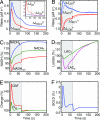A coherent neurobiological framework for functional neuroimaging provided by a model integrating compartmentalized energy metabolism
- PMID: 17360498
- PMCID: PMC1820730
- DOI: 10.1073/pnas.0605864104
A coherent neurobiological framework for functional neuroimaging provided by a model integrating compartmentalized energy metabolism
Abstract
Functional neuroimaging has undergone spectacular developments in recent years. Paradoxically, its neurobiological bases have remained elusive, resulting in an intense debate around the cellular mechanisms taking place upon activation that could contribute to the signals measured. Taking advantage of a modeling approach, we propose here a coherent neurobiological framework that not only explains several in vitro and in vivo observations but also provides a physiological basis to interpret imaging signals. First, based on a model of compartmentalized energy metabolism, we show that complex kinetics of NADH changes observed in vitro can be accounted for by distinct metabolic responses in two cell populations reminiscent of neurons and astrocytes. Second, extended application of the model to an in vivo situation allowed us to reproduce the evolution of intraparenchymal oxygen levels upon activation as measured experimentally without substantially altering the initial parameter values. Finally, applying the same model to functional neuroimaging in humans, we were able to determine that the early negative component of the blood oxygenation level-dependent response recorded with functional MRI, known as the initial dip, critically depends on the oxidative response of neurons, whereas the late aspects of the signal correspond to a combination of responses from cell types with two distinct metabolic profiles that could be neurons and astrocytes. In summary, our results, obtained with such a modeling approach, support the concept that both neuronal and glial metabolic responses form essential components of neuroimaging signals.
Conflict of interest statement
The authors declare no conflict of interest.
Figures




References
-
- Raichle ME, Edvinsson L. In: Cerebral Blood Flow and Metabolism. 2nd Ed. Edvinsson L, Krause DN, editors. Philadelphia: Lippincott Williams & Wilkins; 2002. pp. 413–419.
-
- Sappey-Marinier D, Calabrese G, Fein G, Hugg JW, Biggins C, Weiner MW. J Cereb Blood Flow Metab. 1992;12:584–592. - PubMed
-
- Frahm J, Krüger G, Merboldt K-D, Kleinschmidt A. Magn Reson Med. 1996;35:143–148. - PubMed
Publication types
MeSH terms
Substances
LinkOut - more resources
Full Text Sources

